 |
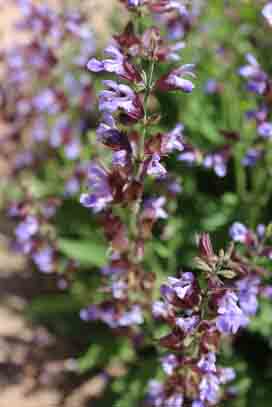 |
Garden Sage - Salvia officinalis
Description
"Salvia officinalis (sage, also called garden sage, common sage, or culinary sage) is a perennial, evergreen subshrub, with woody stems, grayish leaves, and blue to purplish flowers. It is a member of the mint family Lamiaceae and native to the Mediterranean region, though it has naturalized in many places throughout the world. It has a long history of medicinal and culinary use, and in modern times as an ornamental garden plant. The common name "sage" is also used for a number of related and unrelated species." (Wikipedia)
Internet Resources
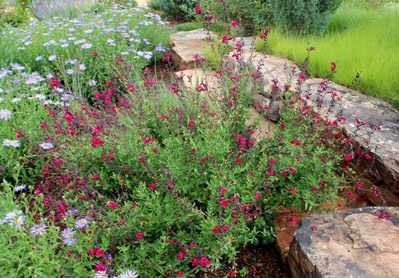 |
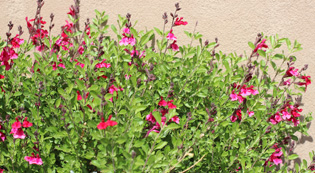 |
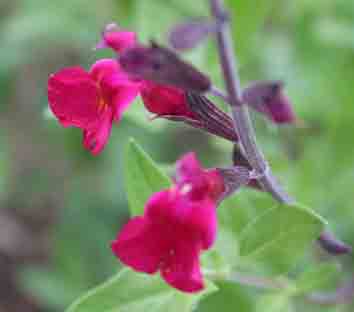 |
Furman's Red Autumn Sage - Salvia greggii 'Furman's Red'
Description
"Salvia greggii 'Furman's Red' (Magenta Red Autumn Sage) - A durable selection of the evergreen subshrub that is native throughout southwest Texas and into Mexico. Light green glabrous leaves vary in length from 3/4 to one inch long. It is an upright plant growing to three to 4 feet tall by 2 to 3 feet wide with aromatic light green glabrous narrow 3/4 to 1 inch long leaves growing to 2 to 3 feet tall by about the same width. The 1 inch long magenta red flowers clothe the branch tips throughout summer and into fall/autumn until short days and cool weather slow then stop their production. Ideally suited to full sun in a well-drained soil with only occasional irrigation. It is cold hardy into the high teens and useful in USDA Zones 7 and above. This is an attractive and tough drought tolerant plant that draws hummingbirds and butterflies into the garden, yet is not that attractive to browsing animals such as deer. This cultivar was selected by the noted plantsman W.A. Furman of Kerrville, Texas in the 1970's and it remains to this day as one of the best and most vigorous of the Salvia greggii cultivars. The species Salvia greggii is naturally found at elevations from 5000-9000 feet in the mountains and rocky slopes of Mexico and southwest Texas. The name Salvia comes from the name used by Pliny for a plant in the genus and comes from the Latin word 'salvere' meaning "to save" in reference to the long-believed healing properties of several Sage species. The specific epithet honors Josiah Gregg, (1806-1850), an American Naturalist who traveled through Texas in the early 1840s, recording the geology, geography and plants all that he saw in his Commerce of the Prairies and later joined a botanical expedition to western Mexico and California. Salvia greggii is commonly called Autumn Sage since it blooms through to first frost but also Texas Sage, but this can confuse it with Leucophyllum frutescens, which shares this common name. We have grown this great cultivar since 1990 from plants first purchased from Monrovia Nursery in 1989. We also grow the very durable white autumn sage Salvia greggii 'Alba'. This description is based on our research and observations made of this plant as it grows in our nursery, in the nursery garden and in other gardens that we have visited. We also try to incorporate comments received from others and appreciate getting feedback of any kind from those who have additional information about this plant, particularly if they disagree with what we have written or if they have additional cultural tips that would aid others in growing Salvia greggii 'Furman's Red'." (San Marcos Growers)
Internet Resource
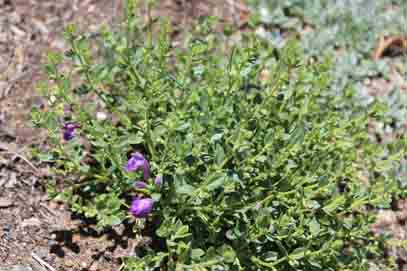 |
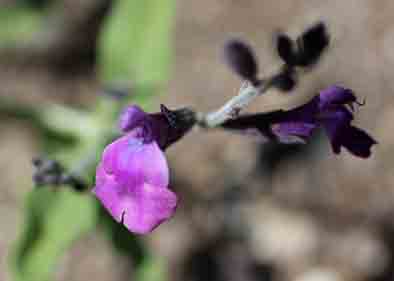 |
Plant w/Flowers |
Flowers |
Ultra Violet Sage - Salvia x 'Ultra Violet'
Description
"'Ultra Violet' is a hybrid sage that typically grows to 18-20" tall and spreads to 24-28" wide. It is reportedly the result of a hummingbird-initiated cross between S. lycioides and S. greggii that occurred in a garden in Fort Collins, Colorado. Violet-pink flowers bloom from mid-summer to frost on stems clad with aromatic dark green leaves. Flowers are attractive to butterflies and hummingbirds. U.S. Plant Patent Applied For (PPAF)." (missouribotanicalgarden.org)
Internet Resources
 |
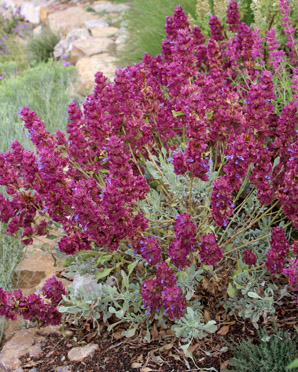 |
Plant w/Flowers
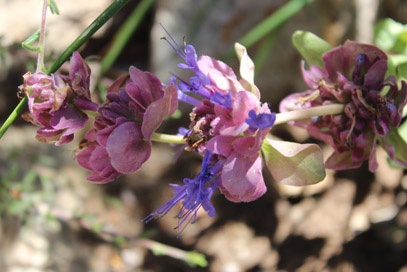 |
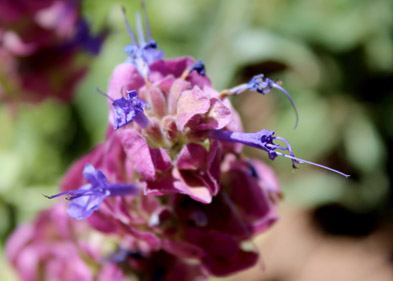 |
Flowers
Mojave Sage - Salvia pachyphylla
Description
"Giant-flowered purple sage has been winning over gardeners the past few years for its remarkable summer blooms and tough-as-nails demeanor. Native to the dry foothills and mountains of southern California, this sage is considered a woody shrub. It features showy, aromatic silver foliage and bicolored flower spikes with lavender-purple calyces and long, hummingbird-pollinated blue flowers. It grows from 24 to 36 inches high." (finegardening.com)
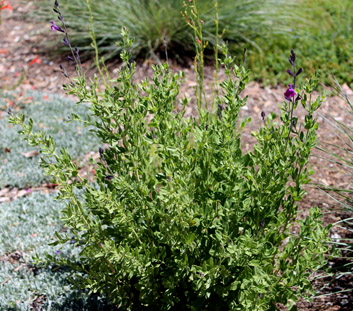 |
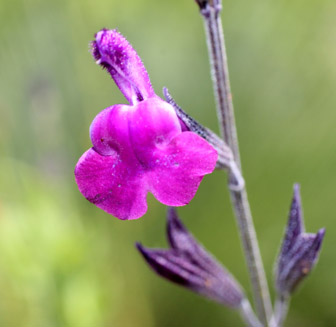 |
Sage, 'Wild Thing Autumn'- Salvia greggii 'Wild Thing'
Description
"With stunning coral-pink blooms over a long season, this Salvia deserves a prominent location in a garden setting. Kept lightly clipped, it can be utilized as a low informal hedge or as a single specimen in a perennial border or container garden." (monrovia.com)
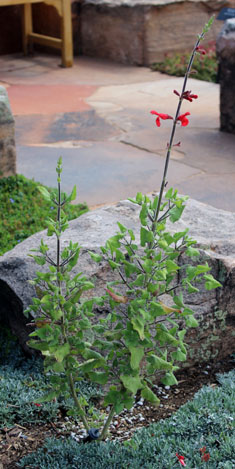 |
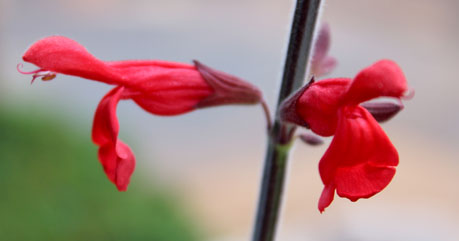 |
Sage, Vermillion Bluffs Mexican - Salvia darcyi 'Vermillion Bluffs'
Description
"Vermilion Bluffs Mexican Sage is a large-sized flowering perennial that is a real attention-grabber. I have found this plant to be an excellent choice for dry, southern exposures and Xeriscapes. It is fairly easy to grow, and produces bright-red flowers throughout the summer. Hummingbirds love this plant- it is not uncommon to see 4 or 5 of them at a time on a single plant.(Outdoor Design Group)
Raspberry Delight Sage - Salvia x greggii RASPBERRY DELIGHT
Description
RASPBERRY DELIGHT is an everblooming hybrid sage that typically grows as a small deciduous sub-shrub to 2-3’ tall and as wide. This sage is most noted for producing a very attractive summer to frost bloom of raspberry-red flowers held above the foliage. Flowers are attractive to butterflies and hummingbirds. Deep green leaves. This plant is sometimes sold in commerce as Salvia x greggii ‘Raspberry Delight’. - Missouri Botanical Garden
Internet Resources